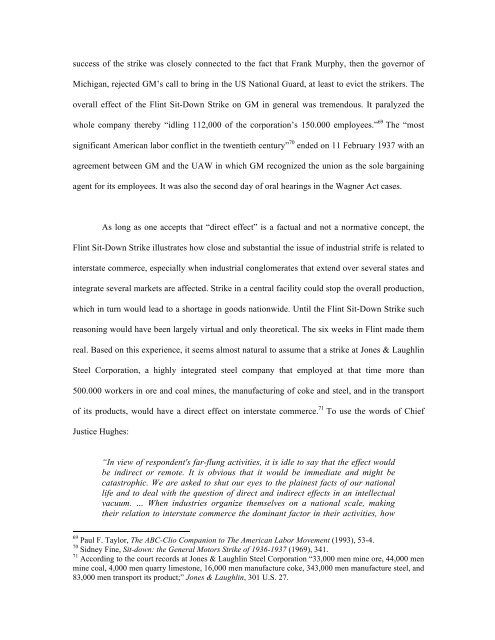Jasper Finke, Crisis and Law - New York University School of Law
Jasper Finke, Crisis and Law - New York University School of Law
Jasper Finke, Crisis and Law - New York University School of Law
Create successful ePaper yourself
Turn your PDF publications into a flip-book with our unique Google optimized e-Paper software.
success <strong>of</strong> the strike was closely connected to the fact that Frank Murphy, then the governor <strong>of</strong><br />
Michigan, rejected GM’s call to bring in the US National Guard, at least to evict the strikers. The<br />
overall effect <strong>of</strong> the Flint Sit-Down Strike on GM in general was tremendous. It paralyzed the<br />
whole company thereby “idling 112,000 <strong>of</strong> the corporation’s 150.000 employees.” 69 The “most<br />
significant American labor conflict in the twentieth century” 70 ended on 11 February 1937 with an<br />
agreement between GM <strong>and</strong> the UAW in which GM recognized the union as the sole bargaining<br />
agent for its employees. It was also the second day <strong>of</strong> oral hearings in the Wagner Act cases.<br />
As long as one accepts that “direct effect” is a factual <strong>and</strong> not a normative concept, the<br />
Flint Sit-Down Strike illustrates how close <strong>and</strong> substantial the issue <strong>of</strong> industrial strife is related to<br />
interstate commerce, especially when industrial conglomerates that extend over several states <strong>and</strong><br />
integrate several markets are affected. Strike in a central facility could stop the overall production,<br />
which in turn would lead to a shortage in goods nationwide. Until the Flint Sit-Down Strike such<br />
reasoning would have been largely virtual <strong>and</strong> only theoretical. The six weeks in Flint made them<br />
real. Based on this experience, it seems almost natural to assume that a strike at Jones & Laughlin<br />
Steel Corporation, a highly integrated steel company that employed at that time more than<br />
500.000 workers in ore <strong>and</strong> coal mines, the manufacturing <strong>of</strong> coke <strong>and</strong> steel, <strong>and</strong> in the transport<br />
<strong>of</strong> its products, would have a direct effect on interstate commerce. 71 To use the words <strong>of</strong> Chief<br />
Justice Hughes:<br />
“In view <strong>of</strong> respondent's far-flung activities, it is idle to say that the effect would<br />
be indirect or remote. It is obvious that it would be immediate <strong>and</strong> might be<br />
catastrophic. We are asked to shut our eyes to the plainest facts <strong>of</strong> our national<br />
life <strong>and</strong> to deal with the question <strong>of</strong> direct <strong>and</strong> indirect effects in an intellectual<br />
vacuum. … When industries organize themselves on a national scale, making<br />
their relation to interstate commerce the dominant factor in their activities, how<br />
69 Paul F. Taylor, The ABC-Clio Companion to The American Labor Movement (1993), 53-4.<br />
70 Sidney Fine, Sit-down: the General Motors Strike <strong>of</strong> 1936-1937 (1969), 341.<br />
71 According to the court records at Jones & Laughlin Steel Corporation “33,000 men mine ore, 44,000 men<br />
mine coal, 4,000 men quarry limestone, 16,000 men manufacture coke, 343,000 men manufacture steel, <strong>and</strong><br />
83,000 men transport its product;” Jones & Laughlin, 301 U.S. 27.
















